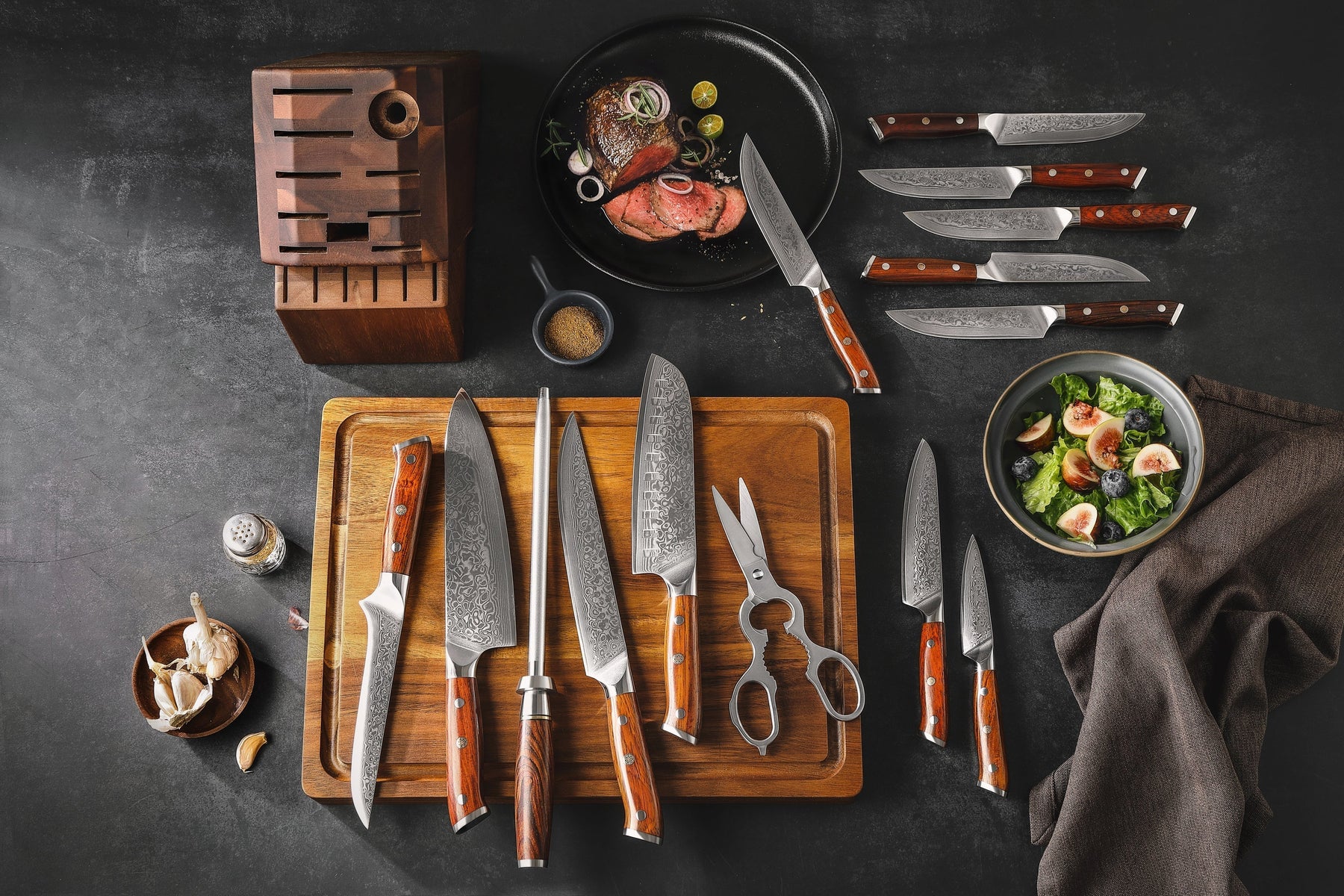
The Best Knife Set for Beginners — What to Look For & Kansai Options
Choosing your first quality knife set can feel overwhelming. You want something that’s versatile, durable, and comfortable — without overspending on tools you won’t use. In this guide, we’ll walk you through:
-
What a beginner really needs in a knife set
-
Key features to prioritize (steel, balance, edge, maintenance)
-
Kansai Knives sets that are especially good for novices
-
Tips for using and caring for your beginner set
By the end, you’ll have confidence in selecting a starter knife set that grows with you — not one you’ll outgrow in months.
1. What a Beginner Really Needs
When you’re starting out, bigger isn’t always better — but completeness matters. A minimal, well-chosen set is more useful than a big block filled with knives you’ll never touch.
A strong beginner set typically includes:
-
A chef’s / Gyuto knife (8–10″) — your daily workhorse
-
A Santoku or utility knife for mid-size tasks
-
A paring knife for detail work
-
A bread / serrated knife (or at least a serrated utility)
-
(Optional but helpful) A boning, carving, or santoku bonus knife
-
A storage solution (slotted block, magnetic strip, sheath)
-
A sharpener or honing rod
Many credible guides emphasize that even 3 knives (chef, paring, serrated) can cover ~90% of kitchen tasks. But giving yourself a little flexibility — especially a bread knife — adds comfort and control.
2. What to Prioritize in a Beginner Set
Here are the attributes that separate a “starter set” from a “frustrating set.”
a) Steel & Heat Treatment
-
Good beginner sets use high-carbon stainless or hybrid steels (e.g. VG-series, AUS, 420/440 variants).
-
Proper heat treatment + tempering ensures the blade holds an edge but isn’t so brittle it chips.
-
Avoid overly soft or stamped blades; they dull fast and feel “mushy.”
b) Edge Geometry & Factory Sharpness
-
A factory edge (~15° per side for Japanese-style blades) gives you cutting performance from day one.
-
A blade with poor sharpening or uneven grind requires early rework — not ideal for someone just starting.
c) Balance & Handle Comfort
-
A well-balanced knife (blade–handle harmony) reduces fatigue and improves control.
-
Handle materials should resist moisture (e.g. stabilized wood, pakkawood, phenolic) and feel secure in grip.
d) Storage & Maintenance Tools
-
A proper block, magnetic strip, or individual sheaths help protect edges and keep safety high.
-
Include or recommend a honing rod and sharpening stone/guide so users maintain rather than replace.
e) Scalability / Modularity
-
A beginner set should be the foundation — you want to add specialty blades (fillet, cleaver, etc.) over time.
-
Ideally, the set’s style, steel, and handle design match the rest of the knife line so additions feel cohesive.
3. Kansai Knives — Best Beginner Sets & Why
Kansai already offers several sets that suit newcomers while retaining the quality and longevity you expect from your brand. Below are standout options:
-
Ikiru 9‑Piece Knife Set
This is a well-rounded set with all essential blades, plus extras for specialization. Great if you want a solid baseline and room to expand. -
Kumo 7‑Piece Knife Set
Slightly more compact, still covers most tasks without overwhelming a beginner’s space. -
Kiyoshi 5‑Piece Compact Chef’s Set
Ideal for small kitchens or users who want only the core essentials — chef, paring, utility, etc. -
Kotsu 9‑Piece Kitchen Knife Set
For those who want extra flexibility: includes specialty knives without committing to a full professional-level block. -
Hone 10‑Piece Full Kitchen Knife Set
A more generous starter, with multiple blade types and storage options — useful if you plan to cook a wide variety of foods early. -
Hokuto Premium Chef’s Knife Set
Slightly “premium starter” — good when you want beginner usability, but don’t want to limit upgrade potential. -
Kuro 10‑Piece Knife Set
Larger set with some advanced knives built in — gives the beginner exposure to specialty blades. -
Ryujin 13‑Piece Knife Set
This is a pro-tier set — more than needed for a true beginner, but excellent if the buyer sees themselves staying serious about knives and cooking.
✅ Example Set Recommendation
For most beginners, Ikiru 9-Piece or Kumo 7-Piece hit the sweet spot: enough coverage without overcomplication. Start with these and add specialty blades later (e.g., boning, nakiri) using Kansai’s matching line.
4. How to Use & Care for a Beginner Set
Getting the most out of your first knife set involves good habits from day one.
a) Break-in / Initial Inspection
-
Check for straight edges and no chips.
-
Use a 1000–3000 grit stone to tweak factory edges if needed (but don’t re-grind heavily).
-
Hone regularly (before every use) using a rod or ceramic steel.
b) Cutting Surface
-
Use soft cutting boards: wood or high-density HDPE. Avoid glass, stone, or ceramic surfaces that dull blades quickly.
c) Cleaning & Drying
-
Always hand-wash immediately after use with mild soap; never put knives in the dishwasher.
-
Thoroughly dry the blade and handle — especially wood or composite handles — to prevent water damage or warping.
d) Storage
-
Use the supplied block, magnetic strip, or knife sheaths.
-
Ensure there’s no contact between blade edges and hard surfaces.
e) Sharpening Routine
-
Hone frequently; use sharpening stones maybe once every few months depending on usage.
-
When you upgrade or add new blades, ensure they match your beginner set in edge angle and steel to keep consistency in feel.
5. Why a Quality Beginner Set Saves You Money
-
Edge retention = fewer replacements: A set with decent steel and treatment won’t need frequent regrinding.
-
Efficiency & less waste: Cleaner cuts preserve food texture and reduce waste.
-
Safety & less damage: Well-balanced knives reduce slips and accidents.
-
Upgrade path: A good base set lets you invest incremental upgrades, not a full replacement.
